The Intel Ivy Bridge (Core i7 3770K) Review
by Anand Lal Shimpi & Ryan Smith on April 23, 2012 12:03 PM EST- Posted in
- CPUs
- Intel
- Ivy Bridge
The Test
It turns out that our initial preview numbers were quite good. The shipping 3770K performs identically to what we tested last month. To keep the review length manageable we're presenting a subset of our results here. For all benchmark results and even more comparisons be sure to use our performance comparison tool: Bench.
| Motherboard: | ASUS P8Z68-V Pro (Intel Z68) ASUS Crosshair V Formula (AMD 990FX) Intel DX79SI (Intel X79) Intel DZ77GA-70K (Intel Z77) |
| Hard Disk: | Intel X25-M SSD (80GB) Crucial RealSSD C300 OCZ Agility 3 (240GB) |
| Memory: | 4 x 4GB G.Skill Ripjaws X DDR3-1600 9-9-9-20 |
| Video Card: | ATI Radeon HD 5870 (Windows 7) AMD Processor Graphics Intel Processor Graphics |
| Video Drivers: | AMD Catalyst 12.3 |
| Desktop Resolution: | 1920 x 1200 |
| OS: | Windows 7 x64 |
General Performance
SYSMark 2007 & 2012
Although not the best indication of overall system performance, the SYSMark suites do give us a good idea of lighter workloads than we're used to testing. SYSMark 2007 is a better indication of low thread count performance, although 2012 isn't tremendously better in that regard.
As the SYSMark suites aren't particularly thread heavy, there's little advantage to the 6-core Sandy Bridge E CPUs. The 3770K however manages to slot in above all of the other Sandy Bridge parts at between 5—20% faster than the 2600K. The biggest advantages show up in either the lightly threaded tests or in the FP heavy benchmarks. Given what we know about Ivy's enhancements, this is exactly what we'd expect.
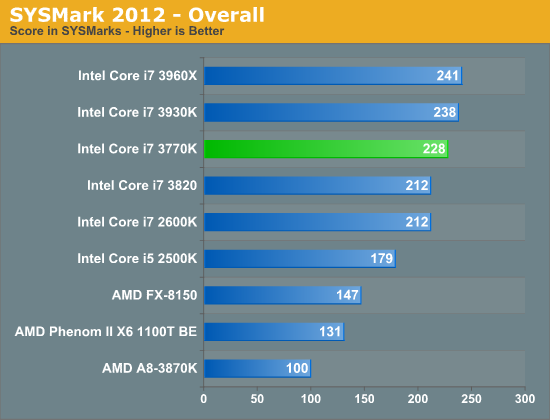
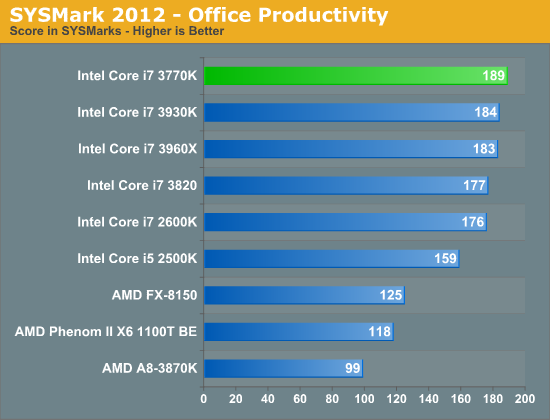

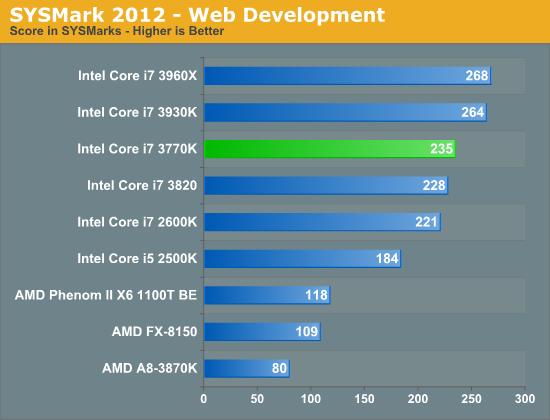
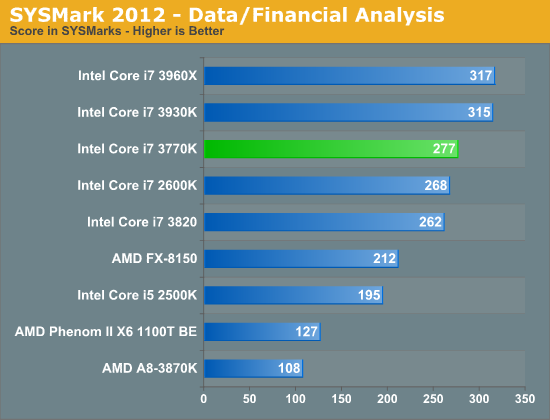
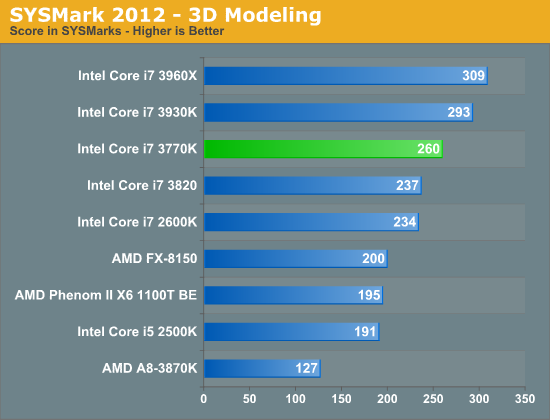


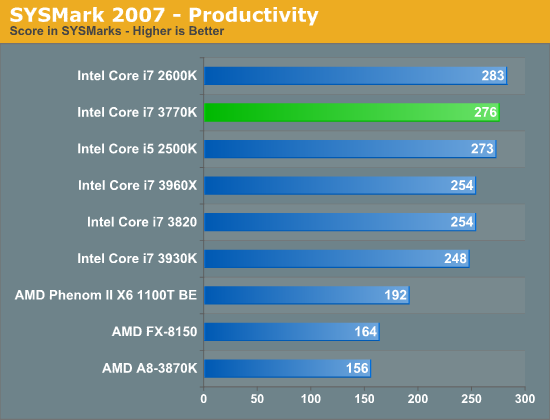
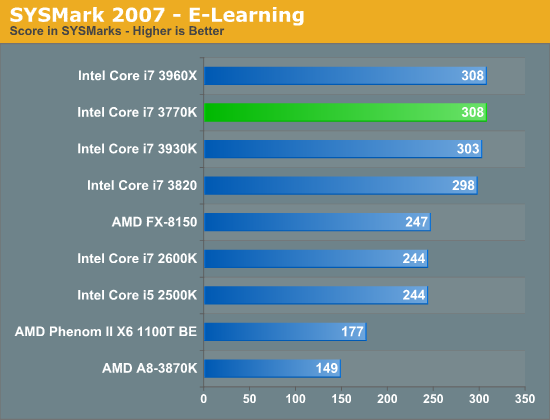
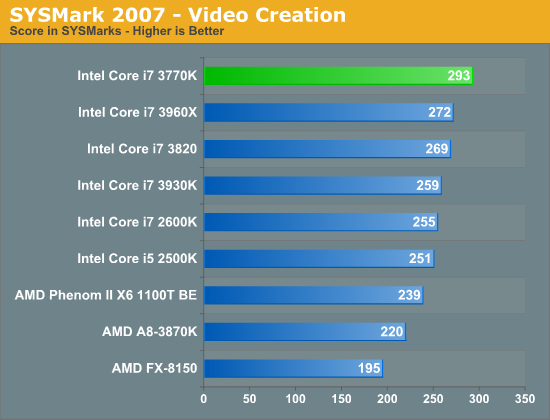

Content Creation Performance
Adobe Photoshop CS4
To measure performance under Photoshop CS4 we turn to the Retouch Artists’ Speed Test. The test does basic photo editing; there are a couple of color space conversions, many layer creations, color curve adjustment, image and canvas size adjustment, unsharp mask, and finally a gaussian blur performed on the entire image.
The whole process is timed and thanks to the use of Intel's X25-M SSD as our test bed hard drive, performance is far more predictable than back when we used to test on mechanical disks.
Time is reported in seconds and the lower numbers mean better performance. The test is multithreaded and can hit all four cores in a quad-core machine.
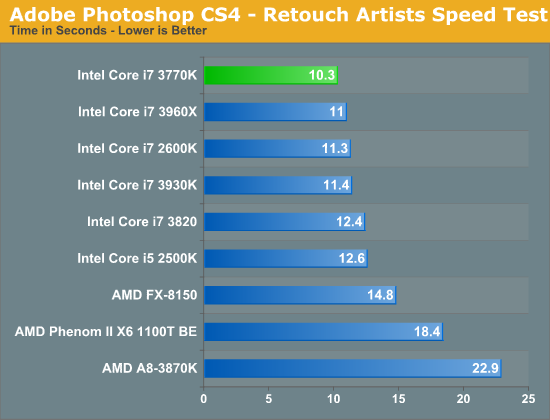
Our Photoshop test is well threaded but it doesn't peg all cores constantly. Instead you get burstier behavior. With the core count advantage out of the way, SNB-E steps aside and allows the 3770K to step up as the fastest CPU we've tested here. The performance advantage over the 2600K is around 9%.
3dsmax 9
Today's desktop processors are more than fast enough to do professional level 3D rendering at home. To look at performance under 3dsmax we ran the SPECapc 3dsmax 8 benchmark (only the CPU rendering tests) under 3dsmax 9 SP1. The results reported are the rendering composite scores.
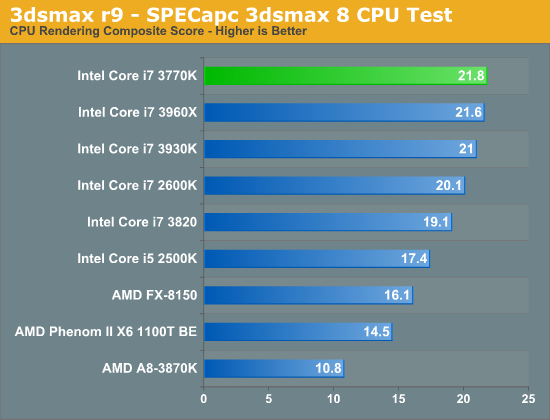
In another FP heavy workload we see a pretty reasonable gain for Ivy Bridge: 8.5% over a 2600K. This isn't enough to make you want to abandon your Sandy Bridge, but it's a good step forward for a tick.
Cinebench 11.5
Created by the Cinema 4D folks we have Cinebench, a popular 3D rendering benchmark that gives us both single and multi-threaded 3D rendering results.
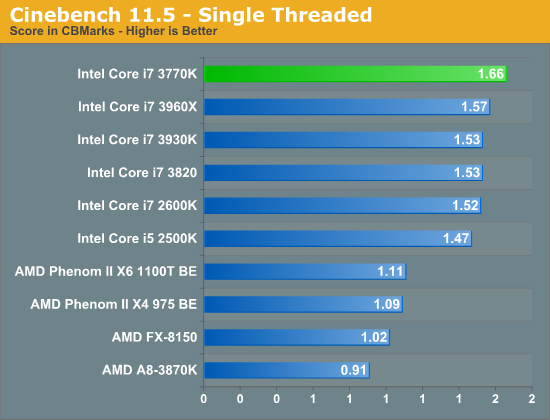
The single threaded Cinebench test shows a 9% performance advantage for the 3770K over the 2600K. The gap increases slightly to 11% as we look at the multithreaded results:
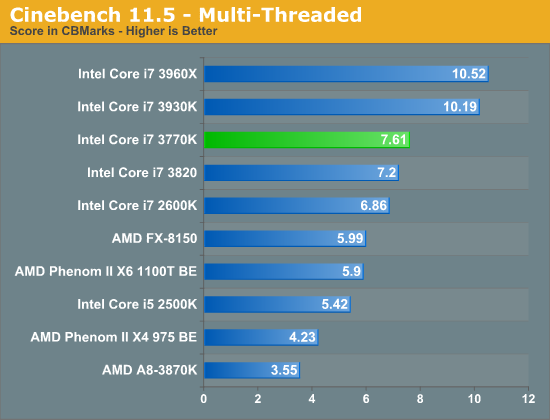
If you're running a workload that can really stress multiple cores, the 6-core Sandy Bridge E parts will remain unstoppable but in the quad-core world, Ivy Bridge leads the pack.
Video Transcoding Performance
x264 HD 3.03 Benchmark
Graysky's x264 HD test uses x264 to encode a 4Mbps 720p MPEG-2 source. The focus here is on quality rather than speed, thus the benchmark uses a 2-pass encode and reports the average frame rate in each pass.

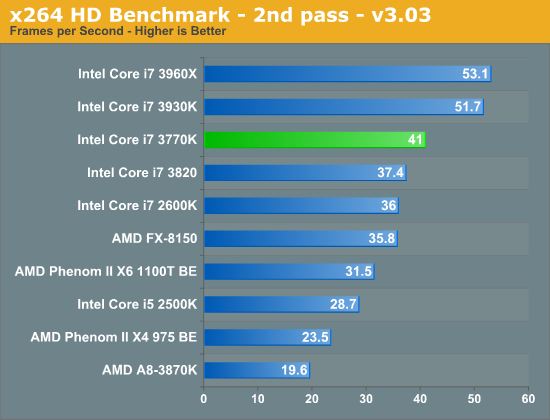
In the second pass of our x264 test we see a nearly 14% increase over the 2600K. Once again, there's no replacement for more cores in these types of workloads but delivering better performance in a lower TDP than last year's quad-core is great for more thermally conscious desktops.
Software Development Performance
Compile Chromium Test
You guys asked for it and finally I have something I feel is a good software build test. Using Visual Studio 2008 I'm compiling Chromium. It's a pretty huge project that takes over forty minutes to compile from the command line on a Core i3 2100. But the results are repeatable and the compile process will stress all 12 threads at 100% for almost the entire time on a 980X so it works for me.
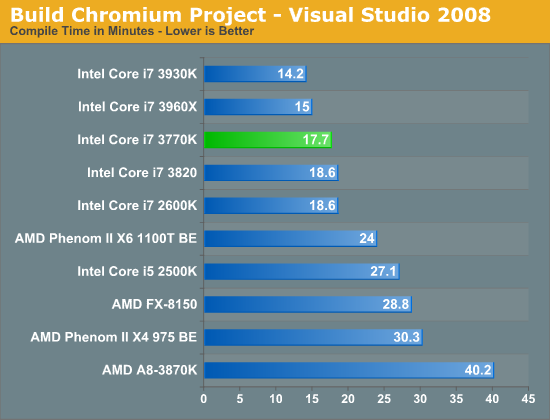
Ivy Bridge shows more traditional gains in our VS2008 benchmark—performance moves forward here by a few percent, but nothing significant. We are seeing a bit of a compressed dynamic range here for this particular compiler workload, it's quite possible that other bottlenecks are beginning to creep in as we get even faster microarchitectures.
Compression & Encryption Performance
7-Zip Benchmark
By working with a small dataset, the 7-zip benchmark gives us an indication of multithreaded integer performance without being IO limited:
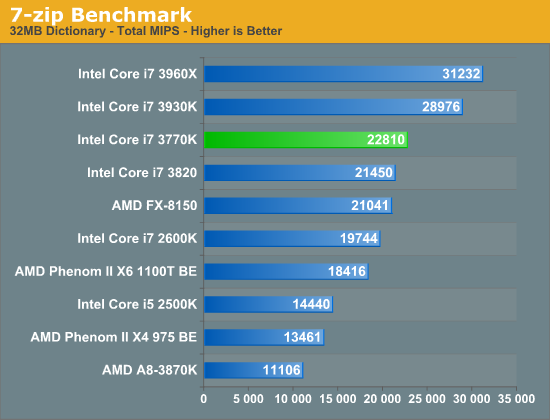
Although real world compression/decompression tests can be heavily influenced by disk IO, the CPU does play a significant role. Here we're showing a 15% increase in performance over the 2600K. In the real world you'd see something much smaller as workloads aren't always so well threaded. The results here do have implications for other heavily compute bound integer workloads however.
TrueCrypt Benchmark
TrueCrypt is a very popular encryption package that offers full AES-NI support. The application also features a built-in encryption benchmark that we can use to measure CPU performance:

Our TrueCrypt test scales fairly well with clock speed, I suspect what we're seeing here might be due in part to Ivy's ability to maintain higher multi-core turbo frequencies despite having similar max turbo frequencies to Sandy Bridge.










173 Comments
View All Comments
frozentundra123456 - Monday, April 23, 2012 - link
According to the Asus review just out by Anand, the Intel HD4000 and AMD HD6620 are essentially even in the mobile space, where it really matters. I dont know where you are getting the "soundly trounces" description, unless you are talking about the desktop. I dont really care about integrated graphics on the desktop, it is just too easy to add a discrete card that soundly trounces either Intel or AMD integrated. I have no doubt that AMD will regain the lead in the mobile space when Trinity comes out. I just question that they will make the kind of improvements that are being speculated about.I also find it ironic that so many people are criticizing IVB for lack of cpu improvement while in the same breath saying bulldozer is OK because it is "good enough" already.
DanNeely - Monday, April 23, 2012 - link
Primarily Einstein@Home.fastman696 - Monday, April 23, 2012 - link
Thanks for the review, but this is new Tech, why use old Tech chipset?JarredWalton - Monday, April 23, 2012 - link
You're being deliberately obtuse in order to set up a straw man.Me: "As I note in the mobile IVB article, mobile Llano GPU performance isn't nearly as impressive relative to IVB as on the desktop."
You: "The mobile variant of the part that launched last year isn't as dominant over the part that just launched today as the desktop variant is?"
In other words, you want us to compare to a product that's not out because the current product doesn't look good. I mention Trinity already, but you act as though I miss it. Then you throw out stuff like, "Thanks for resorting to namecalling" when you've already been insulting with your comments since the get go. "Sad to see this kind of crap coming from Anandtech." "I guess Anandtech's standards have drastically lowered." Put another way, you're already calling me an idiot but doing it indirectly. But let's continue....
How much faster can you do Flash video when it's already accelerated and working properly in Sandy Bridge? Web browsers are basically in the same boat, unless you can name major web sites that a lot of users visit where HD 3000/4000 is significantly worse than the competition.
Does Photoshop benefit from GPUs? Sure, and lots of people use that, including me, but the same people that use Photoshop are also the people who need more than Llano CPU performance, and more than HD 4000 or Llano or Trinity GPU performance. I'm running Bloomfield with a GTX 580, which is more than 95% of users out there. Most serious Photoshop users that I know use quad-core Intel with some form of NVIDIA graphics for a reason. But even running on straight Sandy Bridge with HD 3000, Photoshop runs faster than on Llano with HD 6620G.
Vegas, naturally, is in the same category as video transcoding. I suppose I could have said "video editing/transcoding" just to be broader. There are tons of people that don't do video editing/transcoding. Even for those that do, NVIDIA GPUs are doing far better than AMD GPUs, and NVIDIA + Intel CPU is still the platform to beat. If you want quality, though, encoding is still done in software running on the CPU; Premiere for instance really just leverages the GPU to help with the "quick preview" videos, not for final rendering (unless something has changed since the last time I played with it).
So let's try again: what exactly are the areas where Intel's Ivy Bridge and HD 4000 fall short, where AMD's Llano (or the upcoming Trinity) are going to be substantially better? All without adding a discrete GPU. Llano is equal to HD 4000 for gaming, and seriously behind on the CPU department. There are still areas where AMD's drivers are much better than Intel's drivers, and there are certain tasks (shader and geometry) where AMD is better. Really, though, the only area where Intel doesn't compete is in strictly budget laptops.
chizow - Monday, April 23, 2012 - link
Yes I have heard of a "tick", and IVB has manifested itself as a tick+ as indicated in the article which means we are basically on the 3rd generation of the same architecture introduced with Nehalem in late 2008 with some minor bumps in clockspeed/Turbo modes and overclocking headroom.Both Conroe and Nehalem were pretty huge jumps in performance only 2.5 years apart on one of Intel's Tick Tock cadence cycles and since then, nothing remotely as interesting.
Maybe you should be asking yourself why you aren't expecting bigger performance gains? Or maybe you're still reveling and ogling over Tahiti's terrible price:performance gains in the GPU space? :D
JarredWalton - Monday, April 23, 2012 - link
Yes, because that extra 10W TDP makes all the difference, doesn't it? 45W Llano parts aren't shipped in very many laptops because the OEMs aren't interested. Just look at Newegg as an example:http://www.newegg.com/Product/ProductList.aspx?Sub...
There is one current A8 APU faster than the A8-3520M for sale at Newegg, and it has an A8-3510MX. AMD's own list isn't much better (http://shop.amd.com/us/All/Search?NamedQuery=visio... there's one more notebook there with an A8-3530MX. So that's why we looked at A8-3520M, but if I had an MX chip I would certainly run the same tests -- no one has been willing to send us such a laptop, unfortunately.
But even if we got an MX chip, their GPUs are still clocked the same as the A8-3500M/A8-3520M. We might be CPU limited in a couple games, but while there are Llano parts with 20% higher CPU clocks, that just means Intel is "only" ahead by 60-70% instead of 100% faster on CPU performance.
Joepublic2 - Monday, April 23, 2012 - link
Because stock temperatures are irrelevant (much like your posting) to the end user as long as the chip isn't throttling.samal90 - Monday, April 23, 2012 - link
you people over-analyzed my comment. All I wanted to say is that they are bragging about HD 4000 when it doesn't come close to the current competition.Couple of years down the road, people won't want dedicated graphics cards in their laptops anymore..its too bulky and consumes too much power. We will all have integrated GPUs. the AMD APU is the way to go. To be honest, CPU power is already way more than enough for a lot of things most people use their laptops for (browsing the web, writing documents, play web-based games a.k.a. angry birds on chrome). The extra GPU is for people that either want to do some graphics processing or play some more graphics intensive games. So yes, it is important for the future to have a good and strong integrated GPU and a good CPU. Therefore, I think AMD will win this round. I hope they continue to compete at each other's throats so we see better and cheaper products from both sides.
So as I understand it right now: Go for AMD if you want better GPU, go for Intel if CPU is more important for you. Trinity might narrow the CPU gap however and greatly increase the GPU one. Only time will tell.
chaos215bar2 - Tuesday, April 24, 2012 - link
"Ivy Bridge is hotter, so if you're paying for the AC, it should be a negative impact."Where do you think the dissipated power is going? TDP and overall thermal output are roughly equivalent.
IVB may get hotter, but without measuring TDP overclocked and under load, that could easily be because the die is smaller and doesn't dissipate heat quite as well.
DanNeely - Tuesday, April 24, 2012 - link
"I don't understand this. We're talking about power consumption, not TDP. Heat-wise, Ivy Bridge is hotter, so if you're paying for the AC, it should be a negative impact."Power consumption is TDP. 100W of power is 100joules/second of heat to be disipated; it doesn't matter if the heat's coming off a large warm die, or a small hot one. 100W is 100W.
My current i7-9xx boxes are 130W chips; so just looking at TDP somewhere between 60 and 90W less power at stock (~50 just from the CPU TDP, the higher number the chipset's a theoretical 18 more, probably a lot less in practice, and then whatever cut of the IB's TDP is for the GPU). Probably a wider gap when OCed, but I don't have any stock vs OC power numbers to look at. With AC costs added, cost savings would probably be between $100 and $200/year per box.
Up front costs would be ~$400-550 for CPU + mobo pairs depending on how high up the feature chain I went; probably fairly high for my main box and more bang for the buck on the 2nd.
Looking on ebay for successful auctions it looks like I could get ~$250 for my existing cpu/mobo pairs less whatever ebay's fee is. The very rough guess would be a 2 yearish payback time which is somewhat better that I thought (closer to 3 years).
Not sure I'll do it since I have a few other PC related purchases on the wishlist too: replacing my creaky Core One Duo laptop with a light/medium gaming model or swapping out my netbook for a new ultra portable after Win8 launches might give better returns for my dollar. The latter's battery isn't really lasting as long as I'd like any more. Also, my WHSv1 box is scheduled for retirement this winter.
I am going to have to give it some serious thought though. Part of me still wants to wait for Haswell even though preliminary indications are that it won't be a huge step up; the much bigger GPU and remaining at dual channel memory makes a mainstream hex core part unlikely.